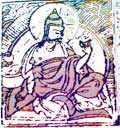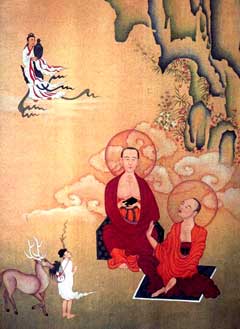
|
|
Home
Medieaval Indian
Logic: Dignaga
|
The Indian Buddhist philosopher and logician Dignaga (A.D. 480-540), a disciple of Vasubandhu,
laid the foundations for the Buddhist teachings on cognition theory and logic. Dignaga's Pramanasamuccaya
(Compendium of the Means of True Knowledge) is one of the greatest works on Buddhist logic.
|
|

|
Indian logic
can be traced back to some centuries B.C. It seems to
have developed independently from Greek logic, even if there are similarities and
parallels. Ancient Indian logic was born in the context of debate on religious and
philosophical matters. In the mediaeval period from about the 4th century on, logic
evolved in dealing with problems of valid knowledge, i.e. perception and inference
|

|
-
Tailoring symbolic clothes for ancient logic [PDF], 505 kB
Opens new window
In order to assess the applicability of modern formal systems to ancient Indian logic, it is worth looking into the development of European logic, where, in the last quarter of the 19th century (earlier than in indology), tools of modern formal logic have been used for the research into ancient logical systems. The triumphal march of Frege's predicate logic in the field of mathematics for which it had been designed was doubtlessly justified. But he situation in the area of history and philosophy of logic encountered severe obstacles which I will describe in some detail. Research in the field of ancient Indian logic switched tools from Aristotelian syllogistic to modern symbolical logic, a process which started in the 1930's. It is interesting to consider the time lag concerning the application of Frege's logic to ancient European and Indian logic respectively: In the beginning of the 1930's, when the eminent Polish logician Lukasiewicz was on his way to overthrow Frege's standard interpretation of Aristotelian logic, the Polish Indologist S. Schayer, who was taught logic by Lukasiewicz, introduced Frege's calculus into the study of Indian logic.
As in the case of ancient European logic, there is a risk that philosophically insensitive misapplication of this method to Indian logic distorts ancient texts and injects artificially generated problems, thus creating obscurity and confusion instead of clarity and precision, for which I will give an example.
-
Problems of transcribing avinaabhaava into predicate logic[PDF], 91 k
Opens new window
Translating ancient logical texts into modern symbolic logic can
be a valuable method of getting access to an otherwise
incomprehensible train of thought. Representing a definition or an argument in
symbolic form, carries the risk of severely twisting the
underlying ideas. Thus the use of modern symbolic logic is often
of doubtful value for interpretational purposes.
-
Stanislaw Schayer's Research on Nyaaya. Journal of Indian Philosophy 32: 295-319,2004[PDF]
96 k
Opens new window
Nyaaya
denotes the oldest Indian logic.
One main topic of Nyaaya is the five-membered scheme which, since its discovery in the West,
has often been compared to Aristotelian syllogistic.
St. Schayer was the first Western Indologist who used modern
Predicate Logic for formulating the "Indian syllogism" in
symbolic outfit. In this paper we discuss in detail the
problematic parts of such a formalization of an ancient
logic.
-
Using Formulas for the Interpretationof Ancient Indian Logic [PDF], 91 k
Opens new window
Utilising western logical concepts and formalisms in a naive manner for the
research on ancient Indian logic is not without risks. There are some
in-built limitations of modern formal logic which prevent it from being
the "natural universal instrument" for the understanding of each and every logical system.
-
Das Rad der Gründe [PDF]
612 k (German language)
Opens new window
Dignaga's
hetucakra (The wheel of reason) was his first work on formal logic.
It may be regarded as a bridge between the older doctrine of trairuupia and Dignaga's own later theory of vyaapti
which is a concept related to the Western notion of implication.
|
|


